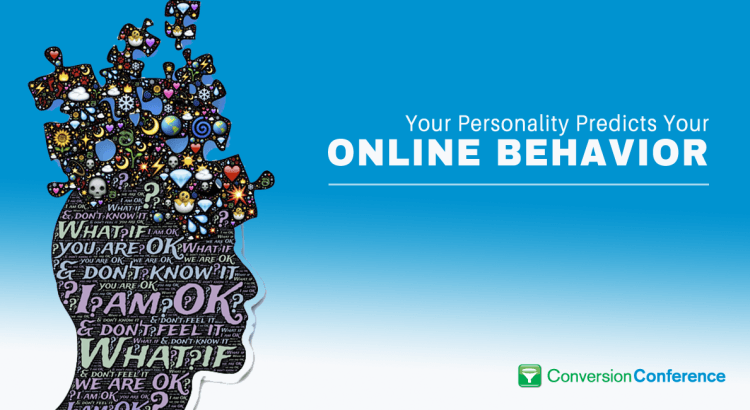Chances are you’ll have encountered a personality test at some point in your career.
Whether you like these tests or not, decades of research have shown that our personality traits go a long way in explaining our behaviours and individual preferences [1].
Your personal(ity) profile
Given that answers from even a short personality questionnaire can enable us to accurately predict real-worldbehaviours – from the likelihood that you’ll be unfaithful [2] to whether you’ll perform well at your job [3] – it’s conceivable that we could also use people’s online activities (the websites you visit, your activity on social networks, etc) to capture personality traits and predict online behaviours.
But what’s bonkers is that you wouldn’t even need to take a test to be profiled. Several studies have shown that it’s possible to assess someone’s personality simply by analysing traces of their actions, such as their Facebook profile [4], the place where they live [5], and even the records of their keyboard and mouse use [6].
Going undercover
If this all sounds a bit too Big Brother for you, you may want to stop for a moment to shut down your Twitter account and switch to browsing permanently in Incognito mode (if you don’t know what this is, ask a porn connoisseur).
On the other hand, if you’re wondering how this could help you personalise the websites and user journeys of your customers, read on…
In a groundbreaking piece of research, Kosinski, Kohli and Stillwell [7] designed a study that would capture people’s personalities in much the same way that we estimate age, gender and income. Using people’s social bookmarks and self-reported tests on their website preferences, the researchers were able to successfully classify over 150,000 participants according to the Big Five personality traits [8].
Over the next few weeks we’ll explore how each of these traits are associated with the types of websites we prefer (from shopping to sports). But to kick us off, I’ve outlined Big Five for you below. And if you want to know how you stack up, you can even take the test online.
Conversion Conference has evolved into Digital Growth Unleashed!
Create the most compelling end-to-end customer experiences. Attract, persuade, serve, and the technology to make it happen – we’ve got you covered with four parallel breakout tracks! Plan early and get the absolute lowest rates possible for May 16-17, 2018 at the Mandalay Bay Casino & Resort, Las Vegas.
1. Openness
This measures the degree to which you are curious and imaginative, and how open you are to seeking out novel experiences. If you score highly in openness, you’re likely to be emotionally more sensitive, politically liberal and tolerant, and you’ll show greater interest in aesthetics, culture and ideas. If you score low in this trait, you’re probably more conventional, authoritarian, conservative and less creative.
2. Conscientiousness
This trait refers to whether you prefer a spontaneous or a more organised existence. If you score highly in conscientiousness you’re probably consistent and reliable, preferring to plan ahead and pursue long-term goals. If you’re a low scorer, you’re likely to be more creative, easy-going and less tied to rules and restraints.
3. Extraversion
You’ll probably have heard of this one. Extraverts tend to be outgoing, friendly and socially active, seeking out the company of others and stimulation from the outside world. If you score highly in this trait you probably enjoy being the centre of attention, and are likely to be energetic and talkative. Introverts tend to be more reserved, preferring introspective and solitary pursuits.
4. Agreeableness
This trait measures how invested you are in maintaining good social relationships. If you’re a high-scorer in agreeableness, you’re probably compassionate, friendly, trusting and cooperative, preferring to adapt to other people’s needs than risk rubbing them up the wrong way. If you score low in this trait, you’re likely to be more assertive and focussed on yourself. You’re less likely to compromise with others, and you’re less governed by societal norms and expectations.
5. Neuroticism
Sometimes referred to as emotional instability, this trait typifies people who tend to experience mood swings and uncomfortable emotions such as anger, anxiety, guilt and depression. High-scorers tend to have a stressed and nervous disposition, whereas low-scorers are usually more calm and self-assured.
This article first appeared on The Web Psychologist Blog.
About the Author
 Nathalie Nahai is an award-winning speaker, Web Psychologist, and author of ‘Webs of Influence: The Psychology of Online Persuasion‘ (Pearson).
Nathalie Nahai is an award-winning speaker, Web Psychologist, and author of ‘Webs of Influence: The Psychology of Online Persuasion‘ (Pearson).
With a background in psychology and digital strategy, she is one of the few leading voices in this field to have both academic and hands-on experience in engineering online persuasion.
Nathalie helps businesses to psychologically optimise for better engagement online, and lectures internationally on the subject of Web Psychology and Online Influence (audiences include Goldman Sachs and Southampton University).
She is also a member of #OgilvyChange, you’ll find her tweets @TheWebPsych and her blog at TheWebPsychologist.com.
[1] Allport, G. W. (1962) The general and the unique in psychological science. Journal of Personality 30, pp. 405 – 422.
[2] Orzeck, T., & Lung, E. (2005) Big-five personality differences of cheaters and non-cheaters. Current Psychology 24, pp. 274 – 287.
[3] Barrick, M. R., & Mount, M. K. (1991) The big five personality dimensions and job performance: A meta-analysis. Personnel Psychology 44(1), pp. 1 – 26.
[4] Golbeck, J., Cristina, R., & Karen, T. (2011) Predicting personality with social media. In CHI.
[5] Gosling, S. D., Ko, S., Mannarelli, T., & Morris, M. E. (2002) A room with a cue: Personality judgments based on offices and bedrooms. Journal of Personality and Social Psychology 82(3), pp. 379 – 398.
[6] Khan, I. A., Brinkman, W., Fine, N., and Hierons, R. M. (2008) Measuring personality from keyboard and mouse use. In ECCE.
[7] Kosinski, M., Kohli P. and Stillwell D. (2012) Personality and Online Behavior. Web Science, 12, June, pp. 1-7.
[8] Costa, P. T., & McCrae, R. R. (2006) Revised NEO Personality Inventory (NEO PI-R): Manual. Hogrefe.

 717 798 3495
717 798 3495



